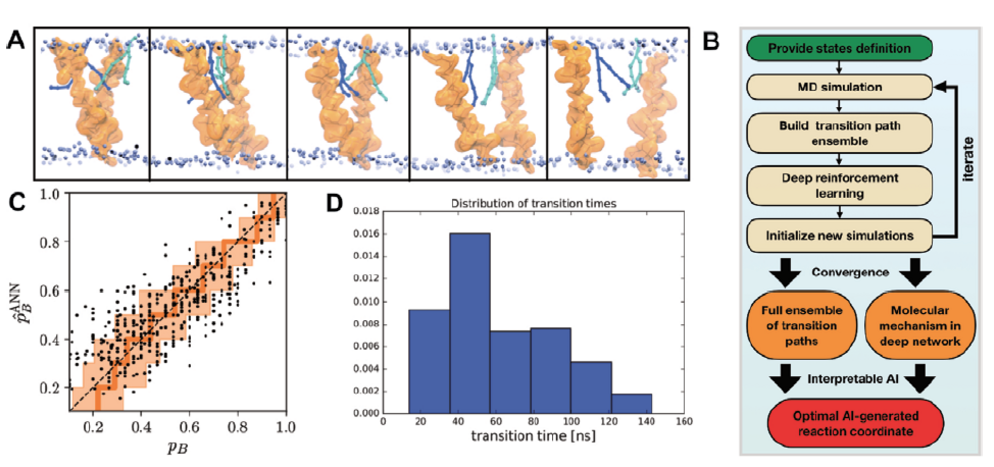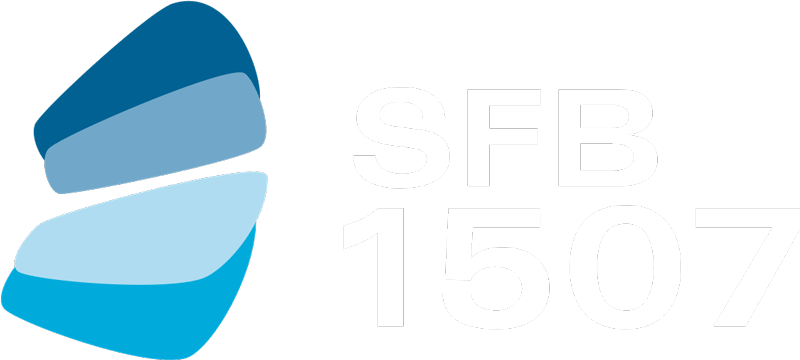Project 09
Artificial intelligence-guided molecular dynamics simulations decipher the activation mechanism of cellular control programs
Principle Investigator: Dr. Roberto Covino
Research Areas: Biophysics, Statistical Physics, Biological Physics

Summary
In cellular membranes, lipids and proteins self-assemble into heterogeneous and dynamic complexes. Membrane proteins and their environment are engaged in a constant dialogue, which is at the origin of many essential regulatory phenomena. Despite its importance, studying the assembly mechanism of membrane proteins with standard approaches is incredibly challenging. We will integrate membrane and protein biophysics, multi-scale molecular dynamics simulations, statistical mechanics, and artificial intelligence to reveal the assembly mechanism in atomistic detail. Modern path theory will provide the thermodynamics and kinetics of the process, which will allow us to understand the role of generic bilayer- mediated interactions. The unfolded protein response (UPR) is a fundamental eukaryotic homeostatic mechanism that protects the cell from stresses threatening its survival. The UPR is at the center of a cellular life or death decision. The ER-transmembrane protein Ire1 controls the activation of the most conserved branch of the UPR. When Ire1 senses ER-stress, it assembles into dimers, oligomers, and large clusters, that initiate a transcriptional and translational response. Despite their fundamental role, the early events determining the UPR’s activation are poorly understood. Integrating experimental and theoretical methods, we will dissect the structural dynamics of the human Ire1 and its organization in dimers and larger supramolecular assemblies. Given the growing interest in pharmacological targeting of Ire1, a deep mechanistic understanding of the UPR’s activation is of outstanding biological and biomedical importance.
P09: PROJECT-RELATED PUBLICATIONS
- Nishimura T, Lazzeri G, Mizushima N, Covino R and Tooze SA (2023) Unique amphipathic a helix drives membrane insertion and enzymatic activity of ATG3. Sci Adv 9: eadh1281
- Dingeldein L, Cossio P and Covino R (2023) Simulation-based inference of single-molecule force spectroscopy. Sci Technol 4: 025009
- Jung H, Covino R, Arjun A, Leitold C, Dellago C, Bolhuis PG, Hummer G (2023) Machine-guided path sampling to discover mechanisms of molecular self-organization. Nat Comput Sci 3: 334-345
- Turoňová B, Sikora M, Schürmann C, Hagen WJH., Welsch S., Blanc FEC., Bülow Sv, Gecht M, Bagola K, Hörner C, Zandbergen Gv, Landry J, Azevedo NTDd, Mosalaganti S, Schwarz A, Covino R, Mühlebach MD, Hummer G, Krijnse Locker J, and Beck M (2020) In situ structural analysis of SARS-CoV-2 spike reveals flexibility mediated by three hinges. Science 370: 203
- Ballweg S, Sezgin E, Doktorova M, Covino R, Reinhard J, Wunnicke D, Hänelt I, Levental I, Hummer G, and Ernst R (2020) Regulation of lipid saturation without sensing membrane fluidity. Nat Commun 11: 756
- Nishimura T, Gecht M, Covino R, Hummer G, Arai H, Kono N, and Stefan CJ (2019) Osh proteins control nanoscale lipid organization necessary for PI(4,5)P2 synthesis. Mol Cell 75: 1043
- Covino R, Hummer G, and Ernst R (2018) The active roles of biological membranes and the hidden side of the unfolded protein response. Mol Cell 71: 458
- Hofbauer HF, Gecht M, Fischer SC, Seybert A, Frangakis AS, Stelzer EHK, Covino R, Hummer G, and Ernst R (2018) The molecular recognition of phosphatidic acid by an amphipathic helix in Opi1. J Cell Bio 217: 3109-3126
- Halbleib K, Pesek K, Covino R, Hofbauer HF, Wunnicke D, Hanelt I, Hummer G, and Ernst R (2017) Activation of the unfolded protein response by lipid bilayer stress. Mol Cell 67: 673
- Chiavazzo E, Covino R, Coifman RR, Gear CW, Georgiou AS, Hummer G, and Kevrekidis IG (2017) Intrinsic map dynamics exploration for uncharted effective free- energy landscapes. PNAS 114: e5494

